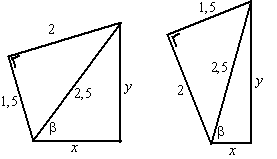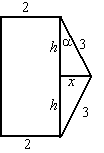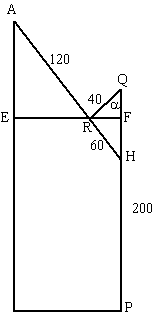|
|||||
| 1. | a. | sinα =
h/20 ⇒
h = 20sinα cosα = x/20 ⇒ x = 20cosα oppervlakte is 2 (0,5xh) + 40h = xh + 40h O = 20cosα 20sinα + 40 20sinα O = 400sinαcosα + 800sinα |
 |
||
| b. | O' = 0 400cosαcosα + 400sinα-sinα + 800cosα = 0 400cos2α - 400sin2α + 800cosα = 0 400cos2α - 400(1 - cos2α) + 800cosα = 0 800cos2α + 800cosα - 400 = 0 2cos2α + 2cosα - 1 = 0 ABC-formule: cosα = (-2 ±√(4 + 8))/4 = 0,366 of -1,366 (maar die laatste kan niet) cosα = 0,366 α = 68,5Ί Dan is O = 400sin(68,5)cos(68,5) + 800sin(68,6) = 880,7 |
||||
| 2. | a. | sinα =
h/5 ⇒ h =
5sinα cosα = x/5 ⇒ x = 5cosα O = 4 (0,5xh) + 2 (8h) = 2xh + 16h O = 2 5cosα 5sinα + 16 5sinα O = 50sinαcosα + 80sinα |
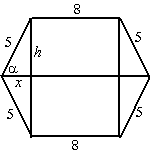 |
||
| b. | Y1 = 50*sin(X)*cos(X) + 80*sin(X)
en dan calc - maximum Dat geeft een maximale oppervlakte van 91,67 (voor α = 65,6Ί) |
||||
| c. | O ' = 0 50cosαcosα + 50sinα-sinα + 80cosα = 0 50cos2α - 50sin2α + 80cosα = 0 50cos2α - 50(1 - cos2α) + 80cosα = 0 100cos2α + 80cosα - 50 = 0 10cos2α + 8cosα - 5 = 0 ABC-formule: cosα = (-8 ±√(64 + 200))/20 = 0,4124 of -1,212 (maar die laatste kan niet) cosα = 0,412 α = 65,6Ί Dan is O = 50sin(65,6)cos(65,6) + 80sin(65,6) = 91,7 |
||||
| 3. | a. | cosα =
TQ/75 ⇒ TQ =
75cosα sinα = PQ/75 ⇒ PQ = 75sinα PQ2 + QM2 = 802 (75sinα)2 + QM2 = 6400 QM2 = 6400 - 752sin2α QM = √(6400 - 5625sin2α) TM = TQ + QM = 75cosα + √(6400 - 5625sin2α) |
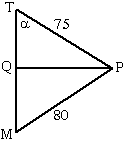 |
||
| b. | De afname van TM is gelijk aan de
helling. Het gaat er dus om wanneer de helling maximaal (negatief) is. PLOT in de GR: Y1 = 75cos(X) + √(6400 - 5625(sin(X))^2) Y2 = nDerive (Y1, X, X) gebruik dan calc - minimum van Y2 Dat geeft X = α = 66,2Ί |
||||
| 4. | a. | tanα =
z/x ⇒
z = xtanα x + y + z = L ⇒ y = L - x - z ⇒ y = L - x - xtanα O = xy + 1/2zx O = x(L - x - xtanα) + 1/2 xtanα x O = xL - x2 - x2tanα + 1/2x2tanα O = xL - x2 - 1/2x2tanα |
 |
||
| b. | O ' = 0 L - 2x - xtanα = 0 L = 2x + xtanα L = x(2 + tanα) x = L/(2 + tanα) |
||||
| 5. |
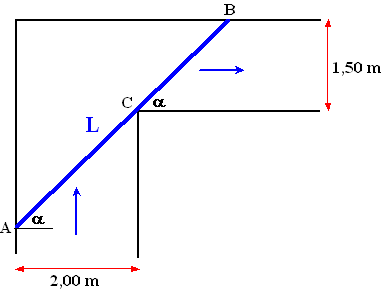 |
||||
| cosα = 2/AC
⇒ AC = 2/cosα sinα = 1,5/BC ⇒ BC = 1.5/sinα L = AC + BC = 2/cosα + 1,5/sinα De langste plaat vind je door uit te rekenen in welke situatie (bij welke hoek ) L minimaal is. Dan is L' = 0 L = 2(cosα)-1 + 1,5(sinα)-1 L' = -2(cosα)-2 -sinα + -1,5(sinα)-2 cosα |
|||||
|
|
|||||
| 2sin3α
= 1,5cos3α tan3α = 1.5/2 = 0,75 tanα = 0,751/3 = 0,9086 α = 42,3Ί Dan is L = 2/cos42,3Ί + 1,5/sin42,3Ί = 4,933 meter en dat is ongeveer 493 cm |
|||||
| 6. | a. | Oppervlakte rechthoek is
x(x + y) = cosx(cosx + sinx) = cos2x + cosxsinx = cos2x + 1/2 2sinxcosx = cos2x + 1/2sin2x |
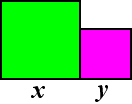 |
||
| b. | O ' = 0 2cosx -sinx + 1/2 cos2x 2 = 0 -2cosxsinx + cos2x = 0 cos2x = 2cosxsinx cos2x = sin2x cos2x = cos(1/2π - 2x) 2x = 1/2π - 2x 4x = 1/2π + k2π x = 1/8π O = cos21/8π + 1/2sin(1/4π) = 1,207 |
||||
| 7. | a. | sinα =
h/1,5 ⇒
h = 1,5sinα cosα = x/1,5 ⇒ x = 1,5cosα O = 0,5 xh + 2h O = 0,5 1,5cosα 1,5sinα + 2 1,5sinα O = 1,125cosαsinα + 3sinα |
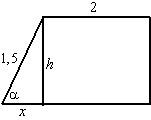 |
||
| b. | O ' = 0 1,125-sinαsinα + 1,125cosαcosα + 3cosα = 0 -1,125sin2α + 1,125cos2α + 3cosα = 0 -1,125(1 - cos2α) + 1,125cos2α + 3cosα = 0 -1,125 + 1,125cos2α+ 1,125cos2α + 3cosα = 0 2,5cos2α + 3cosα - 1,125 = 0 ABC-formule: cosα = (-3 ±√(9 + 11,25))/5 = 0,3 of -1,5 cosα = 0,3 α = 1,266 (∨ α = 5,017) O = 1,125cos1,266sin1,266 + 3sin1,266 = 3,18 m2 |
||||
| c. | maak precies dezelfde
berekeningen, maar met de 1,5 en de 2 verwisseld; sinα = h/2 ⇒ h = 2sinα cosα = x/2 ⇒ x = 2cosα O = 0,5 xh + 1,5h O = 0,5 2cosα 2sinα + 1,5 2sinα O = 2cosαsinα + 3sinα O ' = 0 2-sinαsinα + 2cosαcosα + 3cosα = 0 -2sin2α + 2cos2α + 3cosα = 0 -2(1 - cos2α) + 2cos2α + 3cosα = 0 -2 + 2cos2α + 2cos2α + 3cosα = 0 5cos2α + 3cosα - 2 = 0 ABC-formule: cosα = (-3 ±√(9 + 40))/10 = -1 of 0,4 cosα = 0,4 α = 1,159 (∨ α = 5,124) O = 2cos1,159sin1,159 + 3sin1,159 = 3,48 m2 Dat is 0,30 m2 mιιr en dat is 0,30/3,18 100% = 9,4% meer |
||||
| d. | Zie de volgende figuur: | ||||
|
|
|||||
| De figuur bestaat uit
een driehoek met zijden 2, 1.5 en 2,5 (Pythagoras) plus een driehoek met
zijden 2.5, x en y. Noem de hoek, uit de figuur b. sinβ = y/2,5 ⇒ y = 2,5sinβ cosβ = x/2,5 ⇒ x = 2,5cosβ Oppervlakte tweede driehoek is 1/2 xy = 1/2 2,5cosβ 2,5sinβ = 3,125sinβcosβ Dat is 1,5625 2sinβcosβ = 1,5625 sin(2β) Dat is maximaal als 2β = 1/2π dus β = 1/4π Dat geeft maximale totale oppervlakte 1/2 2 1,5 + 1,5625 = 3,0625 tan-1(2/1.5) = 53,13Ί dus in de eerste figuur uit de opgave is α = 53,13 + 45 = 98,13Ί tan-1(1,5/2) = 36,87Ί dus in de tweede figuur uit de opgave is α = 36,87 + 45 = 81,87Ί |
|||||
| 8. | a. | sinα =
x/3 ⇒
x = 3sinα cosα = h/3 ⇒ h = 3cosα V = 2 1/2 hx + 2 2h V = hx + 4h V = 3cosα 3sinα + 43cosα V = 9cosαsinα + 12cosα |
|
||
| b. | Met de productregel: V' = 9 -sinαsinα + 9cosα cosα + 12-sinα = -9sin2α + 9cos2α - 12sinα = -9sin2α + 9(1 - sin2α) - 12sinα = -9sin2α + 9 - 9sin2α - 12sinα = 9 - 18sin2α - 12sinα |
||||
| c. | V ' = 0 -18p2 - 12p + 9 = 0 ABC-formule: p = (12 ±√(144 + 648))/-36 = -1,12 of 0,448 cosα = 0,448 (want cosα = -1,12 kan niet) α = cos-1(0,448) = 63,36Ί V = 9cos(63,36)sin(63,36) + 12cos(63,36) = 8,99 |
||||
| 9. | a. | Met R en H helemaal omlaag is RA = 120 dus QA
= 120 - 40 = 80 Dan is de hoogte van A gelijk aan 200 + 80 = 280 Met R en H helemaal omhoog is QA = 120 + 40 = 160 Dan is de hoogte van A gelijk aan 200 + 160 = 360 |
|
||
| b. | cosα = QF/40
⇒ QF = 40cosα
= 40cos(1/6π)
= 20√3 sinα = RF/40 ⇒ RF = 40sinα = 40sin(1/6π) = 20 De driehoeken AER en HFR zijn gelijkvormig RF/RH = RE/RA ⇒ 20/60 = RE/120 ⇒ RE = 40 Pythagoras: 402 + AE2 = 1202 AE2 = 12800 AE = √12800 x = PQ - QF + AE = 200 - 20√3 + √12800 = 278,49 |
||||
| c. | Herhaal de vorige
berekening met
α in plaats van
1/6p: cosα = QF/40 ⇒ QF = 40cosα sinα = RF/40 ⇒ RF = 40sinα De driehoeken AER en HFR zijn
gelijkvormig |
||||
| d. | x = 200 - 40cosα
+ 40(9 - 4sin2α)0,5 x ' = -40 -sinα + 40 0,5 (9 - 4sin2α)-0,5 -24sinα cosα x ' = 40sinα - 160sinαcosα(9 - 4sin2α)-0,5 x' = 40sinα (1 - 4cosα (9 - 4sin2α)-0,5) x ' = 40sinα (1 - 4cosα/√(9 - 4sin2α)) |
||||
| e. | Vul
α
= 1/6π
in de formule voor x' in: sinα =
1/2
en cosα = 1/2√3 x ' = 40 0,5 (1 - 4 0,5√3/√(9 - 1)) = -4,49 Dat is negatief dus x wordt kleiner: het uiteinde A gaat omlaag. |
||||
| 10. | a. | cosx = MQ/1
⇒ MQ = cosx sinx = SQ/1 ⇒ SQ = sinx SQ2 + QP2 = 42 QP2 = 16 - SQ2 QP2 = 16 - sin2x QP = √(16 - sin2x) MP = MQ + QP = cosx + √(16 - sin2x) |
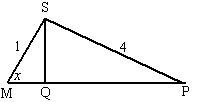 |
||
| b. | het minimum wordt
bereikt als S helemaal links ligt. Dan is MP = PS - MS = 4 - 1 = 3 het maximum wordt bereikt als S helemaal rechts ligt. Dan is MP = PS + MS = 4 + 1 = 5 |
||||
| c. | Als PM = PS is driehoek PMS
gelijkbenig. cosx = 0,5/4 ⇒ x = 82,8Ί en natuurlijk ook met S onder M: x = 277,2Ί |
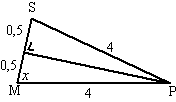 |
|||
| d. | Y1 = cos(X) + √(16 -
(sin(X))^2) - (4 + cos(X)) calc - minimum geeft een verschil van 0,13 voor x = 90Ί |
||||
| 11. | a. | sinx = GB/AB = 2/3 ⇒ x = sin-1(2/3) = 0,73 rad. |
|
||
| b. | sinx = GB/3
⇒ GB = 3sinx cosx = GA/3 ⇒ GA = 3cosx een driehoekje heeft oppervlakte 0,5 GB GA = 0,5 3sinx 3cosx = 4,5sinxcosx Daar zijn er 4 van. Een rechthoek heeft oppervlakte GB BC = 3sinx 3 = 9sinx Daar zijn er 2 van. Totale oppervlakte: 18sinxcosx + 18sinx |
||||
| c. | Met de productregel; S' = 18cosx cosx + 18 sinx -sinx + 18 cosx S' = 18cos2x - 18sin2x + 18cosx S' = 18cos2x - 18(1 - cos2x) + 18cosx S' = 18cos2x - 18 + 18cos2x + 18cosx S' = 36cos2x + 18cosx - 18 |
||||
| d. | S' = 0 36cos2x + 18cosx - 18 = 0 2cos2x + cosx - 1 = 0 ABC-formule: cosx = (-1 ±√(1 + 8))/4 = (-1 ± 3)/4 = 1/2 of -1 cosx = -1 geeft oppervlakte nul. cosx = 1/2 ⇒ x = 1/3p (60Ί) en dat geeft maximale oppervlakte. |
||||
| 12. | a. | O = (0,0) en T = (2,
1) De helling is 1/2 dus de vergelijking van OT is y = 1/2x T = (2, 1) en S = (4, 0) De helling is - 1/2 dus de vergelijking is y = - 1/2x + b 0 = - 1/2 4 + b ⇒ b = 2 dus de vergelijking van ST is y = - 1/2x + 2 |
|||
| b. | lengte van AB = L =
yB - yA op traject OT: L = sin1/4px - 1/2x Voor maximale L stel je de afgeleide nul: L ' = 1/4π cos1/4πx - 1/2 = 0 cos1/4πx = 2/π 1/4πx = cos-1( 2/π) = 0,88 x = 1,12 Dan is L = sin1/4πx - 1/2x ≈ 0,21 vanwege de symmetrie van de figuur vind je op traject ST hetzelfde. |
||||
| 13. | a. | Bij een vierkant is
de figuur symmetrisch in lijn AQ, dus is ∠RAC
= ∠BAP Samen met ∠BAC vormen deze drie een rechte hoek. Daarom is ∠RAC = ∠BAP = 1/6π |
|||
| b. | Teken de lijn van C
loodrecht op AP. Dat geeft punt R. Dan geldt sin(1/6π
+ x) = CR = QP Verder in driehoek ABP: AP = cosx AP QP = cosx sin(1/6π + x) omdat sinα = cos(1/2π - α) geldt sin(1/6π + x) = cos(1/2π - (1/6π + x) ) = cos (1/3π - x) Daarmee is de formule bewezen. |
||||
| c. | O'(x)
= -sinx cos (1/3π
- x) + cosx -sin(1/3π
- x) -1 = cosx sin(1/3π - x) - sinx cos (1/3π - x) = sin(1/3π - x - x) = sin(1/3π - 2x) O'(x) = 0 ⇒ sin(1/3π - 2x) = 0 ⇒ 1/3π - 2x = 0 (mod 2π) ∨ 1/3π - 2x = π (mod 2π) ⇒ 2x = 1/3π (mod 2π) ∨ 2x = -2/3π (mod 2π) ⇒ x = 1/6π (mod π) ∨ x = 2/3π (mod π) x = 1/6π geeft O = 3/4 x = 2/3π valt af omdat 0 ≤ x ≤ 1/3π x = 0 geeft O = 1/2 en x = 1/3π geeft O = 1/2 Conclusie: O zit in het interval [1/2 , 3/4] |
||||
| 14. | a. | De twee zijstukken
hebben elk oppervlakte cosα 2sinα
= sin2α dus samen 2sin2α het middenstuk heeft oppervlakte 2 2sinα = 4sinα Samen geeft dat de gezochte formule. |
|||
| b. | met de
kettingregel: dO/dα = 2cos2α 2 + 4cosα = 4cos2α + 4cosα = 4(cos2α + cosα) gebruik de formule voor cosa + cosb van de formulekaart met a = 2α en b = α dat geeft 4 (2cos1/2(2α + α) cos1/2(2α - α)) = 8cos11/2αcos1/2α |
||||
| c. | dO/dα
= 0 ⇒ cos11/2α = 0 ∨ cos1/2α = 0 ⇒ 11/2α = 1/2π ∨ 11/2α = 11/2π ∨ 1/2α = 1/2π ∨ 1/2α = 11/2π ⇒ α = 1/3π ∨ α = π ∨ α = π ∨ α = 3π Omdat 0 < α < 1/2π zal de oplossing moeten zijn α = 1/3π. Een tekenbeeld van dO/dα is (0)++++(1/3π)-----(1/2π) dus O heeft inderdaad een maximum O(1/3π) = 2 sin (2/3π) + 4sin(1/3π) = 2 1/2√3 + 4 1/2√3 = 3√3 |
||||
| 15. | a. | Bij
hoek t hoort een cirkelsector die t/2π
ste deel van de hele cirkel is, dus heeft zo'n cirkelsector oppervlakte t/2π πr2 = t/2π π 42 = 8t Een driehoek heeft rechthoekszijden 4sint en 4cost (sos cas toa) dus oppervlakte 0,5 4sint 4cost zes driehoeken en twee cirkelsectoren: 6 0,5 4sint 4cost + 2 8t = 48sintcost + 16t = 24 2sintcost + 16t = 24sin2t + 16t |
|||
| b. | Als de
hoogte 4 is, dan is de halve hoogte 2, dus is sint =
2/4 Dat geeft t = 1/6π invullen in de oppervlakteformule: O = 22/3p + 12√3 |
||||
| c. | O is
maximaal als O' = 0 O' = 16 + 24cos(2t) 2 = 0 ⇒ 48cos(2t) = -16 ⇒ cos(2t) = -1/3 Omdat de exacte waarde wordt gevraagd mogen we niet gaan afronden!!!! De hoogte is gelijk aan 8sint De vraag is dus: hoe groot is 8sint als je weet dat cos2t = -1/3??? formulekaart: cos2t = 1 - 2sin2t -1/3 = 1 - 2sin2t ⇒ 2sin2t = 11/3 ⇒ sin2 t = 2/3 ⇒ sint = √(2/3) De hoogte is dus 8√(2/3) |
||||
|
© h.hofstede (h.hofstede@hogeland.nl) |
|||||
